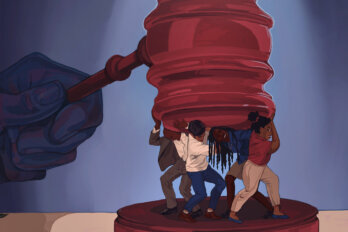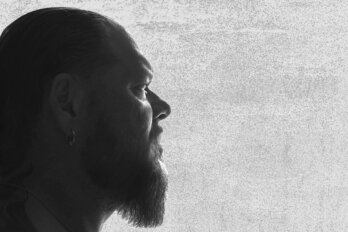sierra nevada de santa marta—I’m trudging down the lower slopes above the city of Santa Marta with a black plastic bag of human bones dangling like a scarf bundle from the handle of my shovel. An assistant to the forensic anthropologist I’ve been shadowing for the past eight days—a big, ribald gravedigger—stops on a ridge overlooking the misty clouds that have rolled in off the Caribbean, and laughs. “Do you want me to carry Doña Tulia? ” he asks. That’s what we have taken to calling the woman we exhumed two days ago, a likely victim of paramilitary violence. “Tulia’s no trouble,” I say, more spooked by my nonchalance than by the bones.
Perhaps I’ve already spent too much time with the gravedigger and the rest of the crew, who have trucked, ridden mules, even canoed into the wildest parts of the country, looking for dead bodies. They are one of a dozen or so such teams assembled in response to a 2005 federal mandate to demobilize and prosecute the “illegal armed groups” that have fought first the guerrillas, then whoever got in their way, for the past fifteen years. Consolidating early on under the banner of the United Self-Defense Forces of Colombia (auc), paramilitary power peaked in December 2002, when nine bosses sat down with President Álvaro Uribe’s representatives to negotiate a peace process that virtually assured them blanket amnesty in exchange for nominal jail terms. Since the law was strengthened three years ago by a defiant constitutional court, public confessions by auc leaders and an avalanche of tips to a toll-free hotline have resulted in the discovery of more than 1,500 partial skeletons, including radial bones bound with twine, tibia shod in platform shoes, and bone shards buried with a Winnie the Pooh wallet.
The team—rounded out by a photographer, a topographer, a prosecutor, and a security detail—was led to Tulia’s final resting place near an abandoned paramilitary camp by a former auc trooper, who covered his face with a rag for most of the hike, to avoid being recognized by locals with long memories. Paramilitary leader Hernán Giraldo Serna, known as the Lord of the Sierra, had been detained, and nobody knew exactly who was in control of the region or what Giraldo’s imminent televised confession might reveal. We slung our hammocks under the sagging roof of a pockmarked adobe hut and lit a fire to cook our dinner of rice and sardines while gunfire echoed in the valley below. Sent up the mountain as an extra precaution, a small anti-guerrilla military brigade set the night watch.
Early the next morning, the Sierra’s snowy peaks reflected orange light across the valley. Still, it wasn’t easy finding the graves of the three or four people we believed had been buried here (two laid head to toe in a single grave, our informant had said); tropical growth thrives on decay. The sun was high overhead by the time we gathered on a steep, vine-covered hill in front of three bathtub-sized depressions. The gravedigger stabbed at the dirt with his shovel as the soldiers took comfortable positions around the perimeter and began swatting at mosquitoes. In due course, it was the informant who spied a rib jutting out of the excavation wall and sifted a heel bone out of the slag. We ended up with parts from two bodies laid out on a bed of oversized leaves, and spent the afternoon in a fruitless search for more. “What do you want? ” the gravedigger ventured. “Bodies don’t like to be found.”
On our way back to Santa Marta, where we are to deliver our bones to the morgue for entry into a national registry of unidentified bodies, the team stops to enjoy a long soak in the crystalline water of the Guachaca River. Tourist buses drop off inner-tubers by the dozen—our first hint that the bustling beach town has taken no notice of our work. Vallenato music spills out of beer halls dotting the roads, until heat knocks the life out of the afternoon.
In my hotel room, Giraldo’s flaccid face fills the television screen. He’s being held accountable for 3,112 separate crimes, including 890 homicides, and yet he claims he knows nothing of mass graves. “But I can ask around,” he adds, his moustache unwavering. Hoy, the local paper, will tuck this news under the fold. There are more recent tragedies to report, such as the assassination of a local businessman, and floods that have washed 2,500 families out of their homes. Within the year, Giraldo and thirteen other bosses will be extradited to the United States on drug trafficking charges, leaving Colombians with storage closets full of bones and few answers.
The crew meets at a bar that night to watch an underdog home team play Argentina’s Boca Juniors in the Copa Libertadores semifinal. Our table quickly crowds with sweaty Aguila beer bottles. The anthropologist speaks pragmatically of her work—“I like to think they’re neither good nor bad, just dead”—and heads home to her parents’ as soon as the game ends, 3–0 Boca. The rest of us stagger down a narrow colonial street to the mirror-walled Tropical Club. The security guys have left their uniforms back at the hotel. The gravedigger and a prosecutor order a bottle of brown rum and give a toast to Tulia. After so many dead bodies, somebody says, it’s time to grab hold of a live one.




